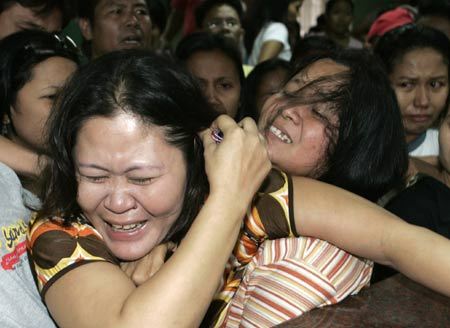The past weekend marked one of the darkest dates in the Philippines' natural disaster-battering history, with reports of floods, landslides, flooded streets and a sunken ship with over 700 passengers on board.

A relative of a ferry passenger cries as she awaits the latest news inside the office of Sulpicio Lines in the port area of Cebu city, central Philippines June 22, 2008. [Photo: Xinhua/Reuters]
The country's Red Cross and disaster relief authorities on Sunday night announced that at least 229 people have been killed, 700 others missing as typhoon "Fengshen" ripped through the archipelago since Friday afternoon.
More people, officials said, are feared dead as the hope of survival is fading for the 700 people on ferry "M/V Princess of the Star" which completely sank off the coasts of central Philippine province of Romblon on Sunday.
So far, only four survivors have reached shores and the rest are "still unaccounted for," Philippine Coast Guard (PCG) spokesman Armand Balilo said.
The 23,000-ton ship of the Sulpicio Lines, carrying more than 700 people on board, left Manila for central Philippine hub of Cebu on Friday. It met rough weather at sea on Saturday noon before the caption ordered to abandon the ship, whose engine had been seriously damaged in high waves and strong winds.
PCG rescuers reaching the scene on Sunday reported that they had failed to "see any survivors or bodies around the upturned ship, or even any life jackets or other flotation devices," the national news network INQUIRER.NET reported.
"The rescuers will also be scouring the other coastal areas to check for the passengers," PCG Commandant Admiral Wilfredo Tamayo told INQUIRER.NET.
"I hope and I pray that many are alright," he said.
Meanwhile, the National Disaster Coordinating Council (NDCC) on Sunday morning reported that floods, storm surge, and landslides have affected 366,444 people, of which, 70,717 are in evacuation centers.
According to the disaster relief agency, 229 people were confirmed dead in typhoon-caused accidents.
Senator Richard Gordon, head of the national Red Cross, said the death toll could also jump dramatically because the casualties reports from places such as Central Luzon are yet to reach Manila.
Heavy rains and strong winds totally destroyed 127 houses and partially damaged 16 others, the NDCC said.
Floodwaters in many parts of the Philippines surged so swiftly that many roads were rendered useless while large number of residents in central Philippines reportedly fled their damaged houses to take refuge on rooftops or in the branches of tall trees.
Electricity, telephone lines and mobile phone signals were cut off in many parts of the archipelagic state, including capital Metro Manila.
The storm has stranded 5,095 passengers, 288 rolling cargo, 90 trucks, 59 passenger buses, 48 small vehicles, and eight sea vessels, the NDCC said.
Packing sustained winds of 120 kilometers per hour and gusts of up to 150 kilometers per hour, the typhoon entered the Philippines from the eastern Samar island on Friday. It shifted course Sunday to the northwest and battered Manila at dawn, dumping heavy rain on the capital.
Moving northwest at 15 kilometers per hour, the storm is expected to exit through the western coast of Central Luzon by Sunday evening, the reports said.
The military has also readied its troops and vehicles to assist in rescue and relief operations, the military authorities said Sunday.